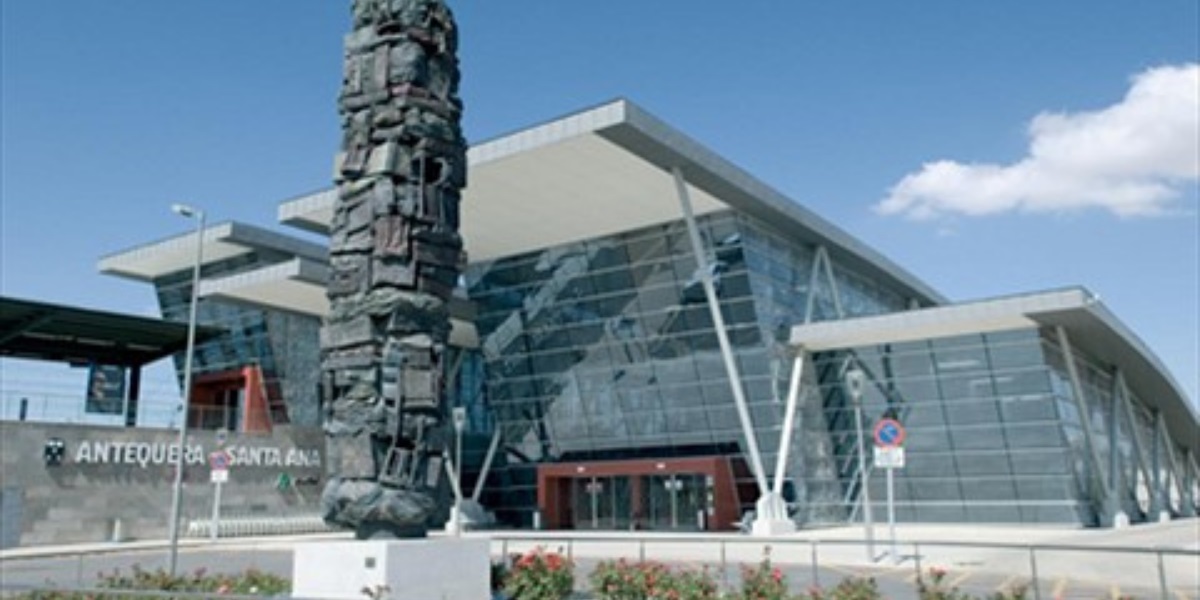“Antequera,” replied Laura. “It’s a town, an hour and a half from where we’re going. They’re building a high-speed rail line. Unfortunately, for the time being, it stops here. We have to change to a local rail line to Granada. It won’t take long.”
The platform was glutted with humanity, the disembarking colliding with the embarking. All of a sudden, like magic, they disappeared – either onto the train or down a rabbit hole of an escalator, into the welcoming, air-conditioned indoors. We were left alone on a platform, eerily silent, that stretched into infinity.
I looked around me to gain my bearings. We had been disgorged onto an ultra-modern rail station resembling a gigantic spaceship, newly landed on alien soil.
“Pops, look behind you,” my two boys twittered. “It’s like being back home in the Rockies.” The snow-topped Sierra Nevada mountains rose above us in sharp contrast to the temperature of 40°C+ (100°F+) and the flat ground surrounding them: uninhabited desert sprawled out before us, olive plantations dotting the far horizon. This vast area of virgin land to one side, the dominating range of mountains on the other, emphasised how insignificant we, as individuals, were.
With Laura tugging my arm, we escaped the heat and dust, descending into the heart of the station.
The fully air-conditioned main thoroughfare below reminded me of an airport terminal. Service booths and luggage check-ins stood at both ends of the building. Visitors’ information, car hire firms and the like were sandwiched in between. The enormous foyer was lit up by sunlight pouring through large windows situated on all sides, just below the roof.
As Laura and the boys found a bench, I scudded across to a food counter. There, I loaded up with goodies: freshly baked galletas – crunchy, milk-white biscuits topped with multi-coloured sprinkles; petite, yellow-creamed horns; and thick, steaming hot chocolate in preparation for the final leg of our journey.
Arriving in Granada, we found ourselves tumbled out of surreal Antequera and slap-bang into 19th-century Europe. We and a dozen fellow passengers teemed out of the antiquated rail station. The modern steel and tinted glass of Antequera were replaced by crumbling stonework. On enquiring, we were told the city centre lay far away. We would need a taxi.
We emerged outside into sweat-inducing heat. It was afternoon, peak siesta time. Only one taxi stood on the ground, its owner snoozing on the back seat. Suddenly, a dozen customers demanded his immediate service. On scooping the first set of passengers, the cabbie promised to call in reinforcements.
An hour later, my family of four were stuffed into a taxi fit for two. Our relief at being rescued from the perishing sun overcame any complaint of being packed like sardines in a tin, having to hold the rest of our luggage – too much for the boot – between our knees and cradled on our laps.
A slew of derelict buildings met us on the way. Decay and despondency reigned supreme. All was in disrepair, all boarded up. Graffiti was scrawled on the walls and across any unprotected windows. Would the rest of the city be as soulless?
My question was soon answered. One minute we were driving through derelict hulks of buildings, the next, through sparkling clean, smart, completely renovated shops and offices. What could possibly have caused this sudden change?
I had no time to ponder, as the taxi came to a halt in front of the Hotel Palacio de Santa Paula.
That evening, we strolled down the Vía Colón in front of our five-star boutique hotel.
The wide, tree-lined boulevard was aglitter with parading fashionistas. The main tourist sites – the Alhambra and Albaicín – were close by and packed with visitors. Granada’s economy seemed to depend almost entirely on their activity. I found no other trade – as observed on our way from the train station. This pocket of affluence was strictly isolated to the vicinity of our hotel.
The Spanish, proud conquistadors of the past, today bowed down to the mammon of tourists and their lucre to resuscitate their moribund economy – with spaceships landed in the middle of nowhere to accommodate their influx.


